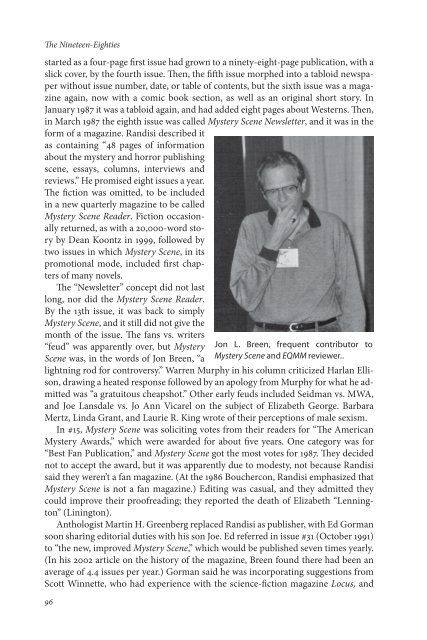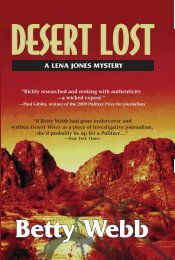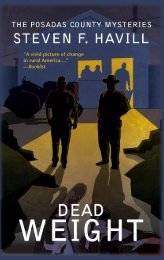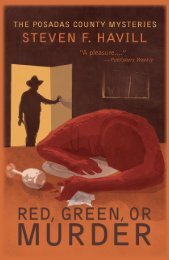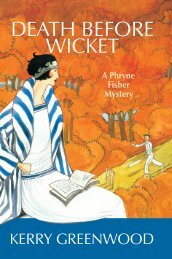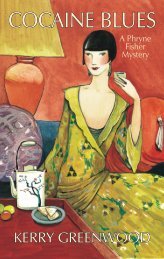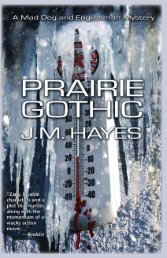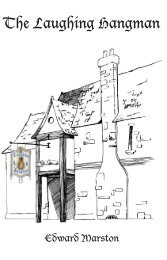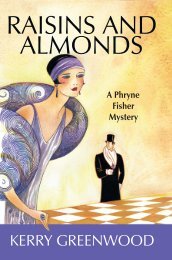The Heirs of Anthony Boucher Marvin Lachman
The Heirs of Anthony Boucher Marvin Lachman
The Heirs of Anthony Boucher Marvin Lachman
You also want an ePaper? Increase the reach of your titles
YUMPU automatically turns print PDFs into web optimized ePapers that Google loves.
<strong>The</strong> Nineteen-Eighties<br />
started as a four-page first issue had grown to a ninety-eight-page publication, with a<br />
slick cover, by the fourth issue. <strong>The</strong>n, the fifth issue morphed into a tabloid newspaper<br />
without issue number, date, or table <strong>of</strong> contents, but the sixth issue was a magazine<br />
again, now with a comic book section, as well as an original short story. In<br />
January 1987 it was a tabloid again, and had added eight pages about Westerns. <strong>The</strong>n,<br />
in March 1987 the eighth issue was called Mystery Scene Newsletter, and it was in the<br />
form <strong>of</strong> a magazine. Randisi described it<br />
as containing “48 pages <strong>of</strong> information<br />
about the mystery and horror publishing<br />
scene, essays, columns, interviews and<br />
reviews.” He promised eight issues a year.<br />
<strong>The</strong> fiction was omitted, to be included<br />
in a new quarterly magazine to be called<br />
Mystery Scene Reader. Fiction occasionally<br />
returned, as with a 20,000-word story<br />
by Dean Koontz in 1999, followed by<br />
two issues in which Mystery Scene, in its<br />
promotional mode, included first chapters<br />
<strong>of</strong> many novels.<br />
<strong>The</strong> “Newsletter” concept did not last<br />
long, nor did the Mystery Scene Reader.<br />
By the 13th issue, it was back to simply<br />
Mystery Scene, and it still did not give the<br />
month <strong>of</strong> the issue. <strong>The</strong> fans vs. writers<br />
“feud” was apparently over, but Mystery<br />
Scene was, in the words <strong>of</strong> Jon Breen, “a<br />
lightning rod for controversy.” Warren Murphy in his column criticized Harlan Ellison,<br />
drawing a heated response followed by an apology from Murphy for what he admitted<br />
was “a gratuitous cheapshot.” Other early feuds included Seidman vs. MWA,<br />
and Joe Lansdale vs. Jo Ann Vicarel on the subject <strong>of</strong> Elizabeth George. Barbara<br />
Mertz, Linda Grant, and Laurie R. King wrote <strong>of</strong> their perceptions <strong>of</strong> male sexism.<br />
In #15, Mystery Scene was soliciting votes from their readers for “<strong>The</strong> American<br />
Mystery Awards,” which were awarded for about five years. One category was for<br />
“Best Fan Publication,” and Mystery Scene got the most votes for 1987. <strong>The</strong>y decided<br />
not to accept the award, but it was apparently due to modesty, not because Randisi<br />
said they weren’t a fan magazine. (At the 1986 <strong>Boucher</strong>con, Randisi emphasized that<br />
Mystery Scene is not a fan magazine.) Editing was casual, and they admitted they<br />
could improve their pro<strong>of</strong>reading; they reported the death <strong>of</strong> Elizabeth “Lennington”<br />
(Linington).<br />
Anthologist Martin H. Greenberg replaced Randisi as publisher, with Ed Gorman<br />
soon sharing editorial duties with his son Joe. Ed referred in issue #31 (October 1991)<br />
to “the new, improved Mystery Scene,” which would be published seven times yearly.<br />
(In his 2002 article on the history <strong>of</strong> the magazine, Breen found there had been an<br />
average <strong>of</strong> 4.4 issues per year.) Gorman said he was incorporating suggestions from<br />
Scott Winnette, who had experience with the science-fiction magazine Locus, and<br />
6<br />
Jon L. Breen, frequent contributor to<br />
Mystery Scene and EQMM reviewer..


